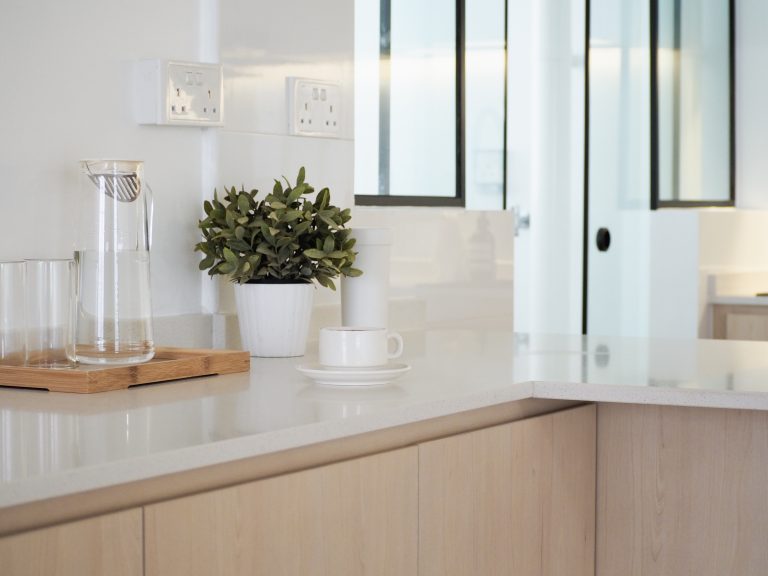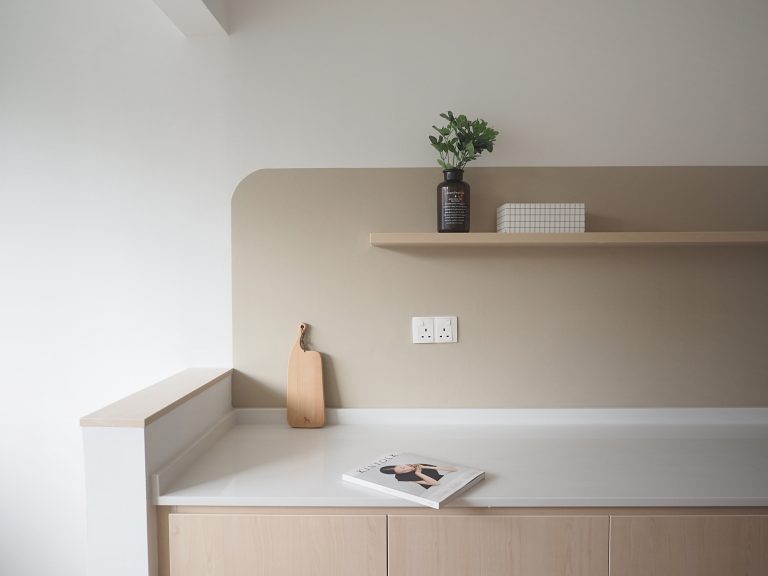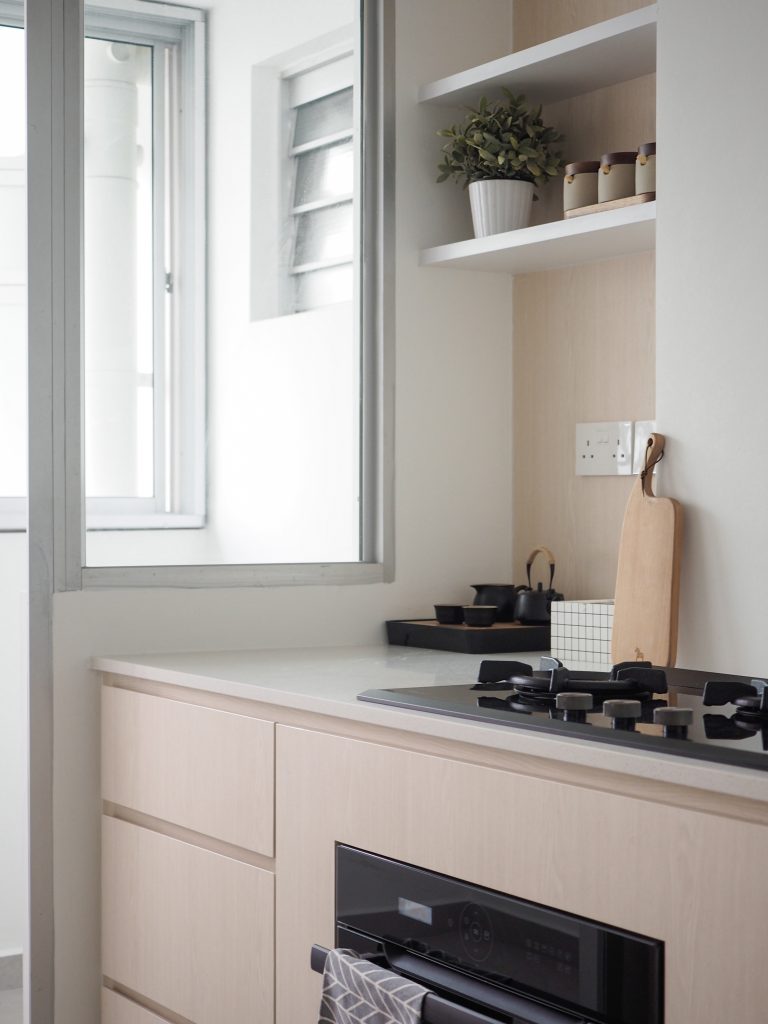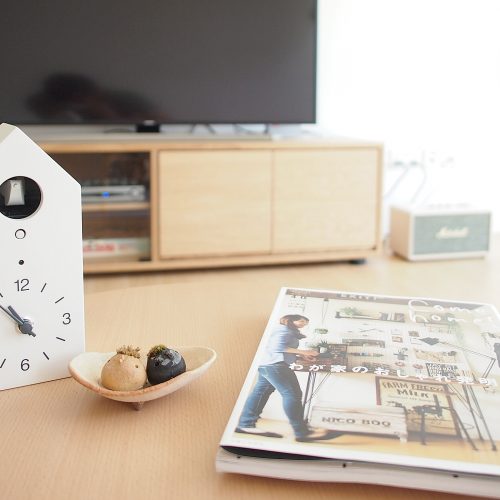
Cleaning & Maintenance Tips For A Minimalist Kitchen
We all love a minimalist kitchen that is clean, full of worktop space, pleasant to look at and most importantly, easy to use. Creating the minimalist kitchen look may just be the least of your worries. The challenging part is how can we maintain the minimalist “look” even after renovations and for the years to come! Apart from organizational tips, here are some cleaning maintenance tips to help you keep your kitchen in tip-top condition.
It all boils down to having good systems and habits! Without them, a kitchen that is used daily will quickly become messy, inefficient and difficult to use. It is important to implement systems that are simple and easy to stick to.
1. Cultivate Good Cleaning Habits
Cultivating simple habits of tidying as we go really goes a long way. At the start, these may seem laborious, but over time they will become a natural part of your life.
- Wash out dirty dishes immediately
Clean as you go! Whenever you have some free time between meal preparations, it is always a good idea to put things away whenever you can rather than leave everything till the end.
For example, when you are waiting for a pot of water to come to a boil, you can use the time waiting to do some cleaning. Things like unloading the dishwasher, washing used pots and pans, putting away cooking utensils that you are done using, and wiping down the countertops.
You will be amazed at how much you can get done in-between times of cooking. That way, once you’re done with your meals, you only have a few dishes to clean making it seem much easier and more doable.
- Wipe out the sink after washing dishes
Though they may sound basic, things like letting the water out of your sink right away, throwing out food scraps and wiping the surface of your sink after you wash your dishes, will make a difference in your kitchen. This will set your sink to be ready the next time you need to use it.
- Clean up spills as soon as possible
This is something that we all know we should do but sometimes neglect when we are in a hurry. The thing is, if you get to a spill as soon as possible, it will be much easier to clean up. Dried-up stains have to be soaked and scraped when they could have been cleaned up with a simple wipe.
- Have a compost/trash bowl
Instead of throwing your food scraps into the sink, it would be much more efficient to place them in a dedicated compost bowl. This will help to not clog your sink and makes it easier to dump all the scraps at once. You can even peel your fruits and vegetables directly into the bowl to save time.
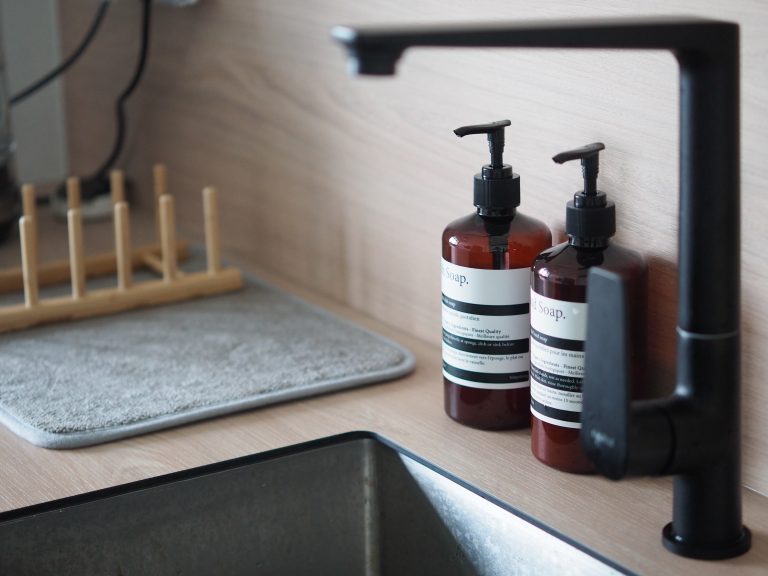
2. Implementing Routines/Schedules
One common reason for not getting certain chores done is forgetting about them. When you have your own set of days for doing certain things, it’s much easier to actually remember to do them. Over time, it will become part of your routine. Below are a few routines you can choose from. To help with keeping track of your kitchen tasks, you can set recurring reminders on digital calendars like Google calendar or use a reminder app.
- For smaller tasks. Have a set time of the day for specific chores.
For smaller chores that need to be carried out daily/more frequently, they are usually small tasks that take no longer than 5 min. Doing certain chores at a certain time of the day can sometimes yield an efficient outcome
For example, if you own a dishwasher, you can unload it after breakfast so that it’s ready to be filled throughout the day. You can also wash the dishes after supper so that you will be able to wake up to a clean kitchen in the morning.
- Weekly/Bi-weekly/Monthly batching
You can also adopt a method called “batching” on top of having good everyday habits. Batching is consolidating tasks of a similar nature and doing them all at once instead of spreading them out over a few days.
You might already be familiar with this method! It’s just like how we do our laundry when the laundry basket is full rather than hand washing the clothes every time after wearing them. In the kitchen setting, this is like running the dishwasher when it fills up.
So when exactly do we clean what? The average population probably has no clue as to when and how to clean their kitchen properly and that’s perfectly normal. We have come up with a manageable routine and premix cleaning solution that you can try out for your kitchen maintenance.
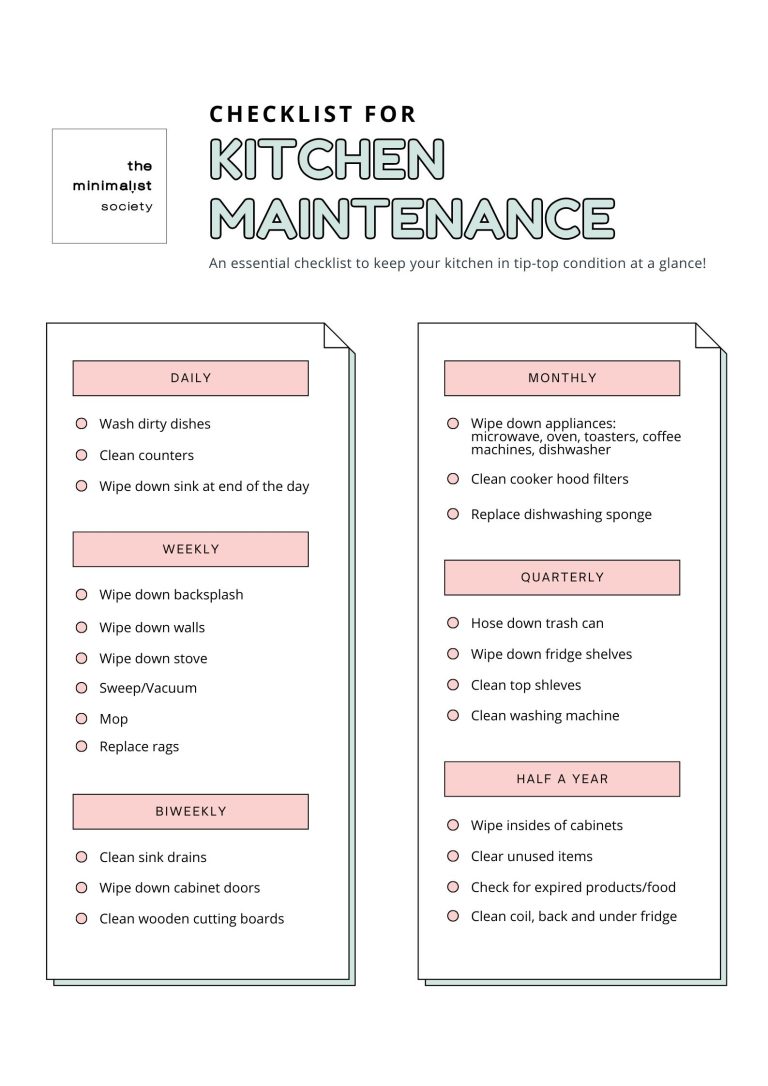
Get home design inspo and renovation tips from us. Be in the know with our latest happenings.
3. Cleaning Hacks For Different Kitchen Areas
Here is a list of the different appliances found and used in a kitchen, areas to clean and how to do them properly.
Let’s start with the things you will need to help you with the cleaning. Most of them are natural products and are also very common and you might already have them in your home!
- Salt
- Lemon
- Baking soda
- Mild dish soap (There’s no standard definition of the term “mild soap” but for cleaning, it means soaps or detergents that are safe for hand washing lightly soiled items.)
- Distilled white vinegar
- Sponge
- Microfiber cloth
- Toothbrush/small brush
Now that you have the supplies you need, it is time to talk about the kitchen cleaning tasks.
Sink
- The sink is one of the most used parts of your kitchen. It is where all your dirty dishes go so keeping it nice and clean is a daily task.
- Maintenance needed: after washing your final dishes of the day, simply add a few drops of dish soap to a wet sponge and wipe down your sink. For the faucets and handles, use some soapy water and a sponge or toothbrush to clean hard-to-reach areas. If spots remain, soak a cloth in distilled white vinegar to remove them.
- Cleaning solution: mild dish soap, distilled white vinegar
Cleaning frequency: once a day or as needed
Quartz countertops
- Some countertops are naturally more porous and prone to scratches and stains than others so do pay attention to the type of cleaning solution you use. As a rule of thumb, avoid harsh chemicals and acidic solutions like vinegar or lemon juice that can etch the stone over time. Instead, you can use mild cleaning solutions and non-abrasive cloths.
- Maintenance needed: soak a microfiber cloth in warm soapy water and gently wipe down the countertops. To remove the excess water on the worktops, you can follow up with a dry cloth.
- Cleaning solution: mild dish soap, microfibre cloth
Cleaning frequency: once a day or as needed
Wall stains
- Grease and spills can accumulate on your kitchen walls, especially the area around your stove. To keep your walls spot-free, you can check for stains once a week.
- Maintenance needed: dampen a microfiber cloth with warm soapy water and gently scrub the area. You don’t have to scrub too hard as it can damage the paint. If the stains are tougher, dab some baking soda on the spot or spray a solution of distilled white vinegar and water for more cleaning power.
- Cleaning solution: mild dish soap, baking soda, vinegar
Cleaning frequency: once a week or as needed
Backsplashes and tile floors
- Similar to kitchen walls, tile backsplashes and floors are prone to splashes and spills.
- Maintenance needed: make a solution of 1 part baking soda to 8 parts of water. Wet a sponge in the solution and gently scrub the tiles.
- Cleaning solution: baking soda
Cleaning frequency: once a week or as needed
Kitchen cabinet faces
- Cabinet faces can collect dust from hands and oils from food.
- Maintenance needed: wipe down cabinet faces using a damp cloth with mild soap. If there is any grease buildup, make use of the distilled white vinegar and water solution and wipe. For recessed faces, use a toothbrush to get into the hard-to-reach corners.
- Cleaning solution: mild dish soap, baking soda, vinegar
Cleaning frequency: twice a month or as needed
Induction stovetop
- Glass and induction stovetops are flat so they are easy surfaces to clean. However, they can scratch easily if you aren’t careful. So when you are cleaning up spills and splashes on glass stovetops, it is good to use non-abrasive cloths and gentle solutions.
- Maintenance needed: sprinkle some baking soda on the stovetop and gently wipe with a damp cloth, followed by a dry cloth.
- Cleaning solution: baking soda
Cleaning frequency: 3 times a week or as needed
Gas range
- There are two components of a gas range that needs to be cleaned regularly: the grates and the burners. To cut through the grease, it is recommended to use some acidic solution like vinegar and water or a slightly abrasive paste made with baking soda.
- Maintenance needed: grates – if they are relatively clean, soak them in warm soapy water and then scrub them. For tougher grease, spray them with the solution of vinegar and water before scrubbing. Burners – remove any food debris from the burner and if there is minimal grease, place the burners in warm soapy water and then scrub them. For stuck-on grease, you can make a paste with equal parts baking soda and water and scrub them gently.
- Cleaning solution: vinegar, mild dish soap, baking soda
Cleaning frequency: once a month or as needed
Hood
- The filter in the hood can collect grease so it is important to clean it once a month to keep it filtering smoothly.
- Maintenance needed: boil the filter in a solution of baking soda and water for 10 minutes. Clean the filter often if you use your stove frequently or have it replaced once a year.
- Cleaning solution: baking soda
Cleaning frequency: once a month or as needed
Oven
- Most ovens have a self-cleaning cycle but before using it, it is important to remove all food debris and liquid spills that have been collected on the bottom to avoid starting a fire in the oven.
- Maintenance needed: use a damp cloth with mild soap to wipe out liquid and food debris before running the self-cleaning cycle.
- Cleaning solution: mild dish soap
Cleaning frequency: once a month or as needed
Microwave
- When you find spills and splashes in your microwave, steam clean them with a combination of hot water and lemons.
- Maintenance needed: cut up 5 to 10 slices of lemon and squeeze some lemon juice into a glass bowl that is filled with just about a cup of water and the rest of the lemon slices. Place the bowl in the microwave and run it for 5 minutes or until the water starts to boil. When that is done, let the steam build up for a minute or two then carefully remove the bowl of water and wipe out the microwave with a damp cloth. To remove any excess moisture, use a dry cloth afterwards.
- Cleaning solution: lemon
Cleaning frequency: once a month or as needed
Loving our beautiful kitchens? Discover actionable tips from our courses to craft your own minimalist kitchen.
Fridge
- To keep your fridge running and looking its best, there are two areas that you need to keep clean: the interior and the condenser coils.
- Maintenance needed: interior – remove all the food from the fridge, as well as the shelves and compartments. Wash the shelves and compartments with warm soapy water and a sponge then dry with a cloth. You can also use the soapy sponge to wipe out the interiors of the fridge and remove any food debris, followed by a dry cloth. Coils – pull the fridge away from the wall and vacuum the condenser coils on the back to remove dust.
- Cleaning solution: mild soap
Cleaning frequency: once a month or as needed for the interior and twice a year for the coils
Dishwasher
- Food debris and hard water stains are what build up in your dishwasher, causing it to lose performance and sparkle.
- Maintenance needed: spinning arms – remove any food debris from water holes in the spinning arms. Drainage area – remove any food debris from the floor of the dishwasher, especially the drainage area, before sprinkling a small amount of baking soda around the drain and scrubbing with a small brush. Filter – remove the filter and clean all parts with a brush and baking soda or warm soapy water. Interior – to steam clean the interiors, place a cup of vinegar on the top rack of an empty dishwasher and run one hot cycle.
- Cleaning solution: vinegar, baking soda
- Cleaning frequency: once a month
- Inside kitchen cabinets
- It is good to clean out your kitchen cabinets to freshen up your space once in a while.
- Maintenance needed: after removing all your dishes and items from your cabinets, use some all-purpose cleaner or solution of vinegar and water to wipe them down. Followed by a dry cloth.
- Cleaning solution: vinegar
- Cleaning frequency: twice a year
Washing Machine
Though washing machines are meant to keep your laundry clean, it can quickly become a breeding ground for germs! So, in order to keep your laundry fresh, cleaning the washing machine regularly will prevent any “sour” smell.
- Maintenance needed:. Start of with soaking the drainage pipe, wiping down the washer drums and running a washing cycle.
Drainage pipe – Ensure that the washing machine is off, detach the pipe with a bucket handy to allow excess water to drain out. Soak the pipe in vinegar to remove any mildew. If there are gunk and stubborn grime, use an old toothbrush with baking soda. washing machine. sing either a cleaning cloth or an old toothbrush, spray
Wipe down of drum – Spray white vinegar around the insides of the drum and wipe down with a microfiber cloth thoroughly. Wipe down the rubber gaskets around the door. Clear off any lint/hair stuck.
Wash cycle – For front load: If your washer have dedicated cleaning cycle, simply add add vinegar to the dispenser till it reaches the max line. You may also add some drops of essential oil to the vinegar. Set it to the highest temperature setting and run a full cycle.
Top load: 1st cycle-Add four cups of vinegar and run a full cycle with the higheste temperature setting. Wait for the washing machine is filled up and right before it starts a cycle, pause it. Allow the mixture to soak the drum for 1 hour then resume the cycle. 2nd cycle – Pour in a cup of baking soda with the highest temperature and run a full cycle. When it is done, allow the drums to air dry.
- Cleaning solution: white vinegar and baking soda or bleach
Cleaning frequency: Quarterly
Insides of kitchen cabinets and open shelves
- The area above your cabinets or open shelves is prone to collecting dust and grease over time and since it’s out of sight, planning a yearly cleaning is a good way to keep the space tidy.
- Maintenance needed: if you find grease, spray the top of the cabinets with the solution of vinegar and water and wipe clean. To reduce the cleaning frequency, you can put in place a sheet of wax paper or newspaper on surfaces that collects dust and grease. You can replace the paper one to two times a year.
- Cleaning solution: vinegar
Cleaning frequency: once to twice a year
So there you have it, these are some tips to help keep your kitchen clean! We hope they inspire you to make the effort to continuously keep it neat and tidy as well.
We also hope this series on Crafting A Minimalist Kitchen has come to be useful to you and your kitchen!
Like us on Facebook to see our latest portfolio.
The Minimalist Society is a brand that focuses deeply on purpose and social good for our society at large. We do so by crafting experiences that makes people’s lives simple through interior design. We have been featured extensively by renowned online portals, in print and on screen, such as The Straits Times, Business Insider, Lianhe Zaobao, The Business Times, Singapore Home and Decor, Lookbox Living, Houzz, Cromly, Qanvast, Vulcan Post, Yahoo and MM2 Entertainment Singapore. At Team Minimalist, simplicity is a goal, a work style, and a measuring stick. By leading a life of purpose, our home owners can embrace only on the things that will add to the mission of significance and ultimately living their best story.


